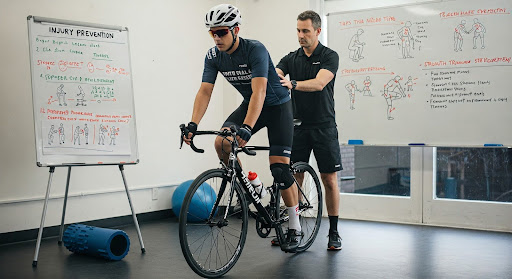As an avid cyclist who’s logged thousands of miles on both mountain trails and road routes, I’ve learned (sometimes the hard way) about cycling injuries. Today, I’m sharing essential strategies to keep you riding safely and recovering quickly when mishaps occur. Whether you’re a weekend warrior or a seasoned athlete, these tips will help you stay healthy on two wheels.
Common Cycling Injuries and Prevention
1. Knee Pain
The knee is one of the most vulnerable joints in cycling, but there are several ways to prevent issues. These include ensuring proper bike fit (particularly saddle height and position), building up mileage gradually rather than overexerting yourself, and maintaining good pedaling form throughout your rides. Regular stretching of the quadriceps and hamstrings can also significantly reduce knee strain.
2. Lower Back Strain
Back pain during cycling typically results from poor posture or incorrect bike setup. To prevent this, focus on strengthening your core muscles, ensure your handlebar reach and height are properly adjusted, and remember to take regular breaks during long rides to give your back a rest. Incorporating yoga or pilates into your routine can help improve flexibility and core strength.
3. Saddle Sores
While saddle sores aren’t a pleasant topic of discussion, they’re a significant concern that can be prevented by investing in quality padding and bike shorts, applying chamois cream for longer rides, and maintaining proper hygiene by keeping the area clean and dry. It’s also important to regularly inspect and replace worn-out saddles or padding.
Recovery Strategies
When injuries do occur, follow these recovery principles:
Immediate Response (RICE Method)
- Rest – Give your body time to heal
- Ice – Reduces inflammation
- Compression – Supports injured areas
- Elevation – Minimises swelling
Long-term Recovery
Getting back on the bike requires a strategic approach: Begin with gentle spinning on flat terrain while carefully listening to your body’s signals to avoid pushing too hard too soon. During this time, consider incorporating cross-training activities to maintain fitness, and don’t hesitate to consult a professional if issues persist. Physical therapy can be particularly beneficial for addressing underlying biomechanical issues.
Preventive Maintenance
The best strategy is prevention through a combination of regular bike maintenance checks, proper warm-up routines before rides, consistent strength training (especially focusing on core and leg muscles), and maintaining a regular stretching routine. Additionally, keeping a training log can help you track your progress and identify patterns that might lead to injury.
Remember, staying injury-free isn’t just about luck – it’s about preparation, awareness, and taking care of both your body and your bike. Happy trails!
What’s your experience with cycling injuries? Share your prevention and recovery tips in the comments below!
Written by Niall O’Riordan UBS
